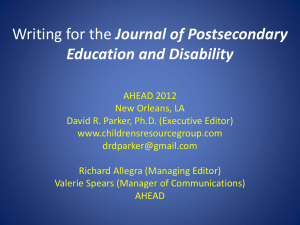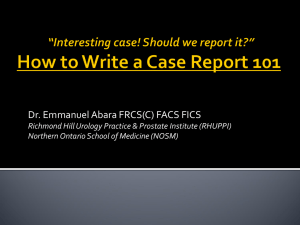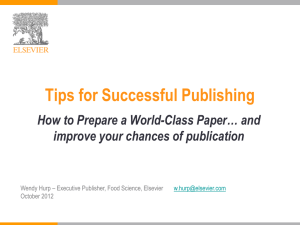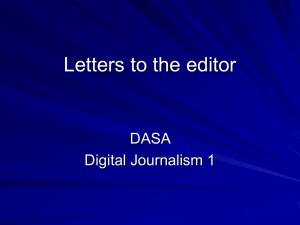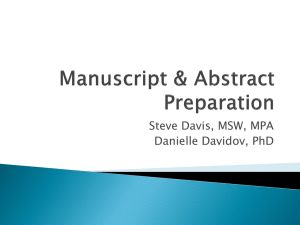Ed Gerstner / 印格致
advertisement
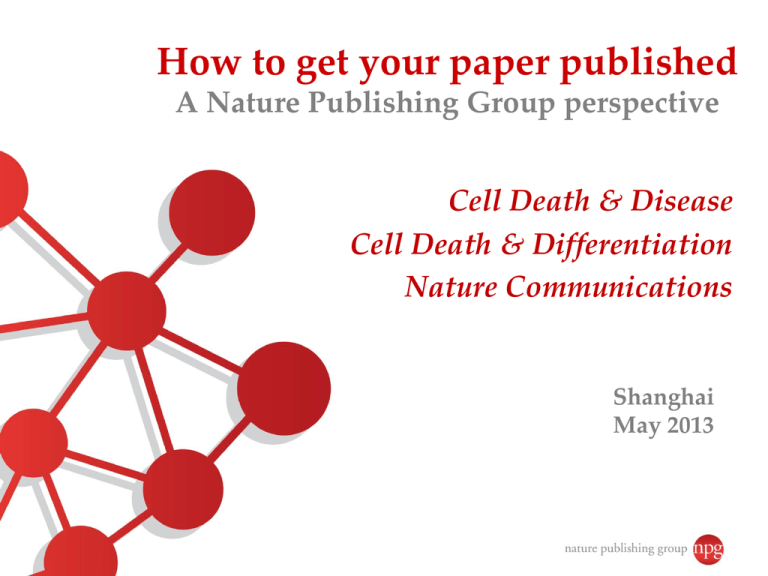
How to get your paper published A Nature Publishing Group perspective Cell Death & Disease Cell Death & Differentiation Nature Communications Shanghai May 2013 Pooja Aggarwal ● BA in Economics and Politics from SOAS and a MPhil in Development Studies from University of Cambridge ● Joined Macmillan in 1999 ● Publisher at Nature Publishing Group since Oct 2005 ● Run a team of 7 staff currently ● Quality not quantity ● Worked on CDD for 8 years now and helped launch CDDis in 2010 ● Responsible for 23 Academic Journals – Financial return / business model / strategy / development Ed Gerstner / 印格致 ● PhD at the University of Sydney • 5 years postdoctoral experience at the Universities of Cambridge, Sydney and Surrey, and at Philips Research Labs, Redhill • Started at Nature in 2002 as the editor and chief writer of the Nature Physics Portal, and NPG Materials Update • Associate editor at Nature and Nature Materials • Helped launch Nature Physics as Senior Editor • Now Executive Editor, China, Nature Communications What makes a Nature journal? • Highly selective, high impact • Full-time professional editorial staff • Editorially independent • Each journal is independent from each other journal — rejection from one doesn’t prejudice consideration by another • Founded in 1869 • The world’s leading, global, scientific journal • Across the full range of scientific disciplines • Nature’s mission: To communicate the world’s best and most important science to scientists across the world and to the wider community interested in science Nature's hits… ... and misses! • Discovery of the neutron (Chadwick, 1932) • Structure of DNA (Watson and Crick, 1953) • Demonstration of the laser (Maiman, 1960) • Magnetic resonance imaging (Lauterbur, 1973) • Polymer LEDs (Burroughes et al. 1990) • Krebs cycle – rejected without review • Beta decay – rejected without review • Pavlov's obituary – published while he was still alive • Memory of water • Schön • ... and surely many more Nature life science journals 1983 1992 1994 1995 1998 1999 2000 2004 Nature physical science journals 2002 2007 2005 2006 2008 2009 Nature Communications ● Editorial criteria: Publishes significant advances that have potential to influence thinking in a field ● Run by a team of independent, full-time, professional editors ● Online-only means we can publish every paper that meets our editorial criteria ● Rapid publication ● Open access options Launched in 2010 Impact Factor: 7.396 Nature Communications celebrates its 3rd birthday! ● First paper published on 12th April 2010 ● In March 2013 the journal published 96 research papers – The equivalent output of 8 Nature research journals ● In 2013 we expect Nature Communications to publish ~1,500 articles – Compared to 2,200 papers published in total by ALL Nature research journals combined in 2012 ● Around 14% of submissions are from corresponding authors based in China ● Around 11% of published papers have at least one Chinabased author Getting published in a Nature journal Publishing starts with new experimental or theoretical results that significantly advances our understanding or technological capability. What are we looking for? Our goal is that every paper should ideally have potential to provoke our readers to think: “WOW! I didn't expect THAT!” “WOW! That's clever (and useful!)” Rule of thumb: if significance can be summarized uniquely in just two sentences, it might be for us! Writing the paper • Explain, don't hype. Show, don’t tell. • The results should speak for themselves • CONTEXT — Not every reader will understand the details but every reader should appreciate your work’s significance • Descriptive not superlative – 'femtosecond spectroscopy' not 'ultrafast-spectroscopy' • Format isn't critical. RevTeX is fine. • Titles in references are helpful Submission process • We strongly prefer full submissions to pre-submission enquiries • Cover letters useful but not mandatory. Be concise! • Referee suggestions – Can be helpful – Please don't suggest former supervisor, former students, friends, parents • We try to honour referee exclusion requests, as long as they are reasonable (3-4 individuals MAX) • Identify all related papers submitted elsewhere Editorial policies • We don’t mind conference presentations or preprint servers — uploading your paper to arXiv is fine! • We do mind publication of peer-reviewed conference proceedings in journals • You may not talk to the media about your work until it is published • You may upload the final refereed version of your manuscript to your website, arXiv, PubMed Central, or any other repository 6 months after publication • You may not upload the published version that we produce at any time, unless it is Open Access Editorial process ● Initial assessment within a week (as far as possible) ● We look for impact not Impact Factors ● At least one editor will read the paper thoroughly, and often several editors ● MOST papers are declined without review ● The decision on whether a paper deserves to be published in the journal in is the editors’ alone ● 2-4 referees per paper and aim for total turnover time of 4-6 weeks for a first decision after review How our decisions are made • Editors make decision based on the substance of our referees' comments – ADVICE not VOTES • Most papers require two rounds of review before publication – In my 11 years as an editor, I accepted the first draft of a paper without revision only THREE times • Almost good enough isn't good enough – Revisions must make substantial progress towards justifying publication Decision letters and what they mean ● Accept in Principle: Minor revisions ● Pending + Questions: – No decision until reviewers concerns are addressed – Encouraging but no commitment, yet – Will probably go back to reviewers ● Open Door: – Major revisions needed – Not clear whether paper meets our editorial criteria ● Closed door: – Rejection — the paper is not for us Responding to referees (P+Q/ OD) • If invited to resubmit, only do so after you have comprehensively addressed all comments • If further experiments are requested, revisions to text alone are not enough • Stay professional — our referees are experts, and they are your peers and colleagues • If an expert in the field has failed to appreciate the significance of your work that may not be their fault, but yours • Diplomacy and persuasion are key… backed by hard data Appeals • Paper is seen again by handling editor and Managing Editor • We take appeals seriously but original submissions take priority • Only a minority of appeals are successful What helps? What does not help? • New data that addresses the major criticisms • “Referees don’t like my work, therefore they are biased!” • Referee (or editor) made factual errors. • “I know who the referee is. He’s a moron!” • “Do you know who I AM!?!” • Celebrity endorsements • Cosmetic revisions NPG also publishes Academic Journals • Over 50 in total now • Over half are published on behalf of learned societies and partners • Specialised niche subject areas with Impact Factors ranging from 2-14 • All offer open access option • External editorial offices and editors • Relationship with society partner Academic Journals ● Official journal of ADMC ● 12 issues per year ● Open access option Key Facts ● 560 published papers in 2010-12 ● 206 papers published in 2012 ● Impact Factor = 8.849 – (Ranked in ISI: 22/180 in Cell Biology, 23/289 in Biochemistry + Molecular Biology category) ● Papers published online within 25 days of acceptance ● Well known and international Editors and Editorial Board Aims and Scope ● Publishes papers within the field of cell death and differentiation, both in normal tissue regulation and disease ● Topics spanning cell biology, molecular biology and biochemistry ● Aim of CDD and CDDis – to provide a unified forum for scientists and clinicians ● Sister journal to CDD – Receives transfers and direct submissions Key Facts ● Fully open access and online only ● 439 published papers since launch in 2010 ● 198 papers published in 2012 ● Impact Factor = 5.333 – (Ranked 45/180 in ISI’s Cell Biology category) ● Papers published online within 25 days of acceptance ● Well known and international Editors and Editorial Board Aims and Scope ● Aims to publish novel observations in the biology of cell death, and translational implications in the pathogenesis of human diseases or relevant animal models ● Covers clinical, translational and applied research within the following topic areas: – Experimental Medicine / Internal Medicine – Cancer / Cancer Metabolism – Immunity – Neuroscience To which journal should you send your manuscript? Questions to ask ● Is your paper within the scope of the journal? ● Does the journal reach an appropriate audience? ● What is the quality of other papers published? ● How easy is electronic submission? ● How quickly will you receive a decision? ● How quickly will your paper be published? How much should you worry about journal Impact Factors? • IFs are important and currently is the only way to rank journals in terms of quality that is accepted by all • (CDDis 2011 = 5.333 / CDD 2011 = 8.849) • Obviously there are journals with higher IF than CDD and CDDis – e.g. Journal of Cell Biology (10.264), Molecular Cell (14.178) or Nature Cell Biology (19.488) • Butwell as impact, it is equally important to think about the reach, promotion and service delivered to you as an author by the Publisher Journal scope and content Both CDDis and CDD publish the following article types: – – – – – Original Article Review Correspondence News + Commentary Mini Review (CDD only) – Plus commissioned Meeting Reports, Book Reviews and Editorials Commissioned Editorials and Reviews • Reviews are commissioned by the Editor and Senior Editors but can be submitted by authors directly too • They provide scope for expression of personal views and are a good way to address sometimes controversial studies and ideas • Should serve as an authoritative reference and thus should cover all recent advances • References should be complete and include all important papers in the area • Submitted reviews are still peer-reviewed • Reviews tend to be more highly cited What are the Editors looking for? • • • • • Novel or original findings Credibility Clarity of data and conclusions Interesting to the international community Brevity • Good standard of English (seek help if necessary) • Compliance with ethical standards and approval by Institutional Review Board if appropriate • Disclosure of possible conflicts of interests by all authors • References complete and up-to-date When you submit you should… • Read the Instructions to Authors • Check that you have included all persons who expect to be co-authors in the ‘correct’ sequence. You must also ensure at this stage that all authors agree to the submission and have declared any conflicts of interest • Confirm that your paper is not under consideration by another journal • Draw the Editor’s attention to the existence of any similar version of the data that might be in press or already published which should not come as a surprise • The Editor will probably agree to consider for publication papers containing data that have already appeared in an unreviewed format, e.g. meeting abstracts How to Prepare & Submit your Paper Regular manuscripts submitted to the journal usually follow a standard format, summarised as follows: – – – – – – – – – – – Cover letter including a COI statement Title page followed by keywords Abstract Introduction Materials and Methods Results Discussion Acknowledgements References (Vancouver format) Tables Figures How to Prepare & Submit your Paper As you prepare to up-load your paper to the CDD and / or CDDis online submission system at www.nature.com ensure that you have available: • All authors’ names, postal and e-mail addresses • The complete manuscript with all Images, Tables and Figures in appropriate format and resolution • A cover letter mentioning any additional information that may be helpful for the Editor • Name of corresponding author with full address, e-mail address and telephone number At this point you can also opt-in to request NPG to deposit the authors accepted version into PMC on behalf of all authors upon publication. Peer Review Process On submission of your manuscript you will receive an acknowledgment and the manuscript is then assigned to the Editor-in-chief or a Co-editor who: – Determines if the manuscript is within the scope of the Journal – Assesses if the paper should be sent out for review or not, and if the answer is yes then – Select three experts to review the manuscript for scientific quality and novelty – Based in part on the reviewers’ reports he/she makes an initial decision to accept, to reject or to ask for revision Editorial response to corresponding author • The initial editorial decision is sent to the corresponding author by e-mail • The e-mail letter usually says either: - (a) Your paper may be acceptable if you revise it, or - (b) Your paper is unacceptable as is but may be accepted if you re-submit after revision or re-submit as a Letter to the Editor - (c) Your paper is not acceptable - (d) Your paper does not meet the aims and scope of CDD and recommendation is made to transfer to CDDis • If asked to revise, there might be a time limit on re-submission • If you resubmit, the paper will probably be sent for review again. • You could be asked to carry out further revision When You Re-Submit • You must include a covering letter indicating how you have responded to each point raised by the editor and reviewers. - The best way to do this is simply to repeat in your letter each of the reviewers’ comments in italics and follow each with your own response. Any changes you have incorporated into the revised manuscript should be highlighted by using a typeface other than black • Even if you judge the reviewer to be incompetent or not to have understood your paper, still use tactful language! • Don’t hesitate to contact the editorial office if you have heard nothing after say 4 weeks Editorial response to corresponding author ● If you resubmit, the paper will probably be sent for review again. You may be asked to carry out further revision ● Acceptance!! (Not guaranteed) ● You could be asked for further revision ● Rejection is still possible at this stage Open Access across NPG ● We have 8 fully open access Academic Journals ● All other academic journals offer authors the option of publishing open access ● Nature Communications – launched in 2010 ● Scientific Reports – launched in 2011 ● Open access means your paper will be freely accessible to anyone (and forever) ● Increases exposure ● Increases impact ● Ensures your colleagues will see you work! Open Access and CDD / CDDis CDDis is fully open access and so accepted authors agree to pay an article processing charge (APC) to have their final published version available open access ● Fee is £2,000 for original research articles ● APC is dependent on article type and licence chosen [Correspondence articles are £670, CC-BY prices are £2,100/ £700] ● Compliant with major funding agencies ● Final version automatically deposited into PubMedCentral ● Choose one of three creative commons licences CDD offers authors the option to publish open access [CDD prices are £2,500/ £670 for ND/ SA and £2,700/ £700 for CC-BY] The Production Process ● Accepted manuscripts are passed to the production department ● A production editor will ensure paper meets the journal’s house style: – Check punctuation, grammar, and consistency of terminology – Check pharmaceutical names and abbreviations – Check references – Figures and tables are formatted and the manuscript is typeset ● Reasons for delays to starting work on a paper: – Artwork in wrong format – Licence To Publish form not complete ● Page proofs are e-mailed to the corresponding author within 8 weeks of acceptance – corrections to a pdf version ● Once paper is returned a Document Object Identifier (DOI) number is assigned and paper is ‘queued’ for on line publication Online Publication ● Your final published version should appear online within 25 days of acceptance. ● It now has a ‘Digital Object Identifier’ (DOI) number and date online and can now be cited. ● Your paper is recorded in PubMed as soon as it is published online, ensuring more people see your article over a longer amount of time Once Published : Promotion & Visibility ● Selected articles are press-released ● Electronic table of contents (e-ToC alerts) with direct links to all newly published articles are sent to registered users each month ● Selected articles appear on www.nature.com homepage and NPG’s community and subject based platforms, both of which highlight the best articles across NPG ● All articles are included in key abstracting, indexing and linking services including ISI, PubMed, Medline, Embase and Crossref. ● We also look to cross-promote with other relevant NPG titles and across www.nature.com ● Adverts / flyers / reprint collections / conference promotion / online promotions / banners / email campaigns / direct mail Some Web Stats CDDis • More than 505,000 page ‘views’ from 206,000 visitors to the website in 2012 - Average of 600 visitors each day CDD • More than 2.1 million page ‘views’ from 912,000 visitors to the website in 2012 - Average of 2,500 visitors each day • Over 23,400 abstract views in 2012 • Over 104,000 abstract views in 2012 • Over 309,000 full-text article views in 2012 • Over 1.38 million full-text article views in 2012 • Over 9,000 e-alert registrants • Over 78,000 e-alert registrants Readers can search for CDDis and CDD articles from homepage of www.nature.com which has over 1.15 million users per month Wide audience is targeted and reached through a variety of marketing methods in print and online Why do we care about China? Why do we care about China? Why launch an office in China? ● To bring the best Chinese research to the world ● To help Chinese scientists better understand what we’re looking for ● To identify any hurdles that Chinese researchers may face, and to help them overcome them Summary ● Look carefully at the scope of your paper – does it add something new to the field? ● Choose a journal to submit to ● Read the instructions for authors carefully ● Get help with your presentation or language if appropriate ● Submit your paper ● Take all feedback positively ● NPG publishes a whole range of journals for you to choose from ● Our reach is global - we will make your paper visible and publish it quickly ● Contact us with any questions Thank you! 谢谢! E-mail us at: e.gerstner@nature.com / p.aggarwal@nature.com
